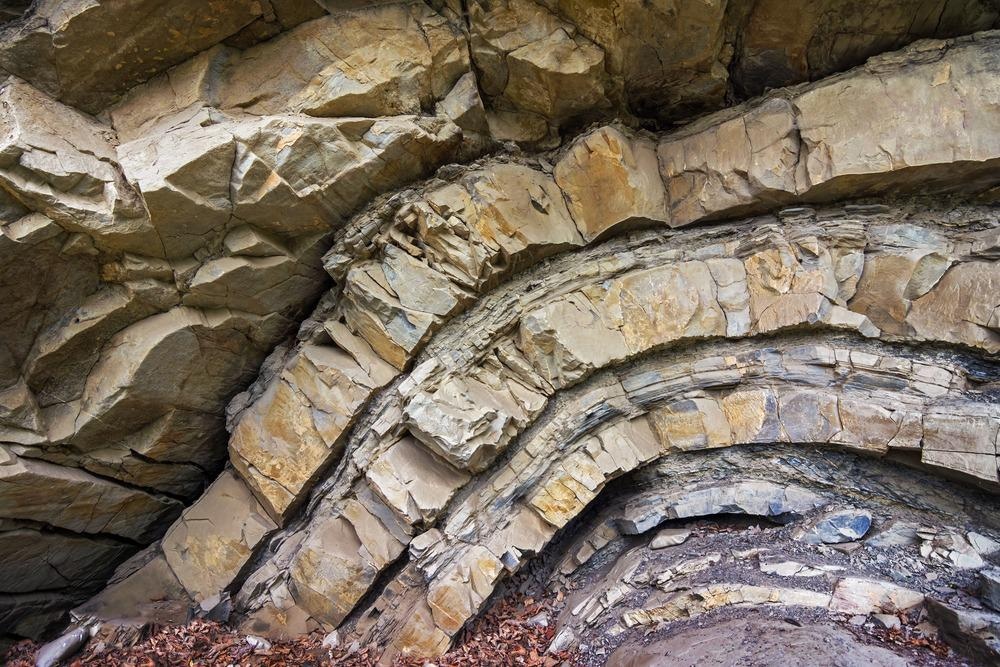Atomic force microscopy is a type of scanning probe microscopy with an incredibly high spatial resolution. Measurement works by scanning the surface of interest with a probe with an incredibly sharp tip. The tip has a small cantilever attached that is bent with varying amounts of force as the tip rasters over the surface.

Image Credit: Brum/Shutterstock.com
By using a laser beam and photodetector focused on the tip, any changes in the degree of bending in the tip can be detected optically. Many atomic force microscopy setups use interferometers to monitor the force on the tip as a highly sensitive and precise way of measuring even very small changes.1
Changes in the force on the tip happen as a result of the surface-tip interaction changing. This change may arise because of an alteration in the distance between the surface and the tip due to a depression in the surface.
The surface-tip interaction may also alter due to the presence of different elements or the composition of the surface.
While standard atomic force microscopy is not inherently well-suited to elemental identification, variations of the technique that make use of molecular-modified tips can enhance the element sensitivity of atomic force microscopy in combination with its excellent spatial resolution.2
The high spatial resolution is not the only feature that makes atomic force microscopy an incredibly powerful technique for studying materials. As well as being compatible with measuring many different material types, including glasses, ceramics and biological samples, atomic force microscopy can measure many different types of interaction forces. This includes electrostatic and covalent forces as well as capillary forces.3
Geology Characterization
Compatibility with a diverse range of material types has made atomic force microscopy a very popular technique in materials science. Recently, atomic force microscopy has become increasingly popular for geological applications.4
One advantage atomic force microscopy has over electron microscopy methods such as transmission electron microscopy and scanning electron microscopy is that atomic force microscopy measurements do not require the use of high vacuum conditions. Preparing samples for measurement in electron microscopy can also involve taking very thin slices (for transmission measurements) or very careful cleaning to remove any debris that may interfere with the imaging process.
Many geological samples are also too delicate to withstand the high vacuum conditions within an electron microscope. Therefore, atomic force microscopy offers an effective way of achieving very high spatial resolution for imaging without requiring a large amount of sample preparation.
An atomic force microscope can work in three modes: contact mode, non-contact mode, and tapping mode.
Contact mode
Contact mode is ideal for rapid scans but risks damaging the surface as the tip is always in contact. The tip can also be damaged by the friction generated as the tip is rastered over the sample.
Non-contact mode
Non-contact mode overcomes the damage issues but is very slow to perform measurements.
Tapping mode
Tapping mode tries to compromise between the extremes of contact and non-contact measurements.
Many hard geological samples need to be measured in tapping mode, where the tip only has brief moments of contact with the surface.4
For many geological samples, atomic force microscopy can be used to capture the full three-dimensional topography of the sample surface.
For geological applications, being able to image the full topography of the surface is of particular interest as many naturally occurring samples such as coal have particularly complex surface topographies.
Samples with complex networks of pores caused by weathering or other phenomena are also well-suited to atomic force microscopy measurements that can characterize the pore dimensions and structural shapes.
Looking Ahead
Atomic force microscopy is a non-destructive technique so as long as suitable care is taken not to damage the surface with a tip, even precious samples of archeological value can be measured.
Surface details on the micro- and nano-scale can be imaged and the lack of requirement for high vacuum conditions means measurements can be made on samples while undergoing some kind of processing, such as high pressure or temperature treatment.
In geology, as well as sampling the surface topography, one of the appealing aspects of using atomic force microscopy to measure samples is the ability to also recover information on properties such as the adhesion force and elastic modulus of a sample.4
This determines how the sample will respond to stress and strain which may provide insight into potential deformations of the geological sample.
For geology, the ability to capture nanoscale information on samples, including at the liquid-solid interface, and to observe mineral geochemical behavior in situ, means an atomic force microscopy is a powerful tool.
There is still the need for the development of more standard protocols for experimental procedures such as tip selection as well as developing faster scanning methods so the full surface of highly heterogeneous geological samples can be explored.
References and Further Reading
- Erlandsson, R., McClelland, G. M., Mate, C. M., & Chiang, S. (1998). Atomic force microscopy using optical interferometry. Journal of Vacuum Science & Technology A, 6(2), 266–270. https://doi.org/10.1116/1.575440
- Schulz, F., Ritala, J., Krejci, O., Seitsonen, A. P., Forster, A. S., & Liljeroth, P. (2018). Elemental Identification by Combining Atomic Force Microscopy and Kelvin Probe Force Microscopy. ACS Nano, 12, 5274–5283. https://doi.org/10.1021/acsnano.7b08997
- Butt, H., Cappella, B., & Kappl, M. (2005). Force measurements with the atomic force microscope: Technique , interpretation and applications. Surface Science Reports, 59, 1–152. https://doi.org/10.1016/j.surfrep.2005.08.003
- Wang, K., Taylor, K. G., & Ma, L. (2021). Advancing the application of atomic force microscopy ( AFM ) to the characterization and quantification of geological material properties. International Journal of Coal Geology, 247, 103852. https://doi.org/10.1016/j.coal.2021.103852
Disclaimer: The views expressed here are those of the author expressed in their private capacity and do not necessarily represent the views of AZoM.com Limited T/A AZoNetwork the owner and operator of this website. This disclaimer forms part of the Terms and conditions of use of this website.